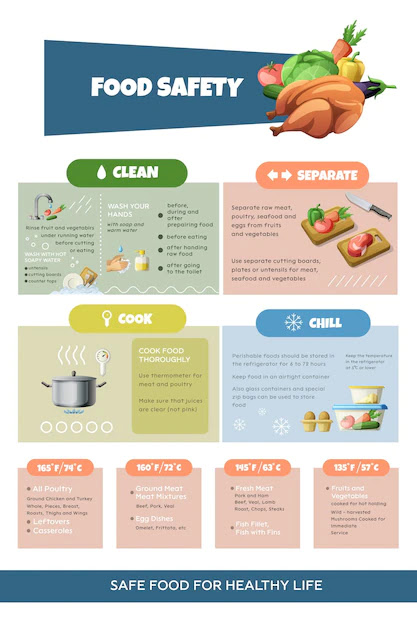Food hygiene plays a pivotal role in safeguarding public health and preventing the spread of diseases. Proper handling, storage, and preparation of food are essential to maintain its quality and safety. By adhering to stringent hygiene practices, we can ensure that the food we consume is free from harmful bacteria, viruses, and contaminants. In this blog, we will delve into the significance of food hygiene and explore some practical tips to maintain a clean and safe food environment.


Food Hygiene
Practical Tips for Food Hygiene
1. Personal Hygiene:
- Regularly wash hands with soap and warm water for at least 20 seconds before handling food.
- Avoid touching your face, hair, or any other potential sources of contamination while preparing food.
- Wear clean and suitable protective clothing, such as aprons and disposable gloves, to prevent cross-contamination.
2. Food Storage and Preservation:
- Avoid touching your face, hair, or any other potential sources of contamination while preparing food.
- Wear clean and suitable protective clothing, such as aprons and disposable gloves, to prevent cross-contamination.
2. Food Storage and Preservation:
- Store raw and cooked foods separately to prevent the spread of harmful bacteria.
- Maintain appropriate temperatures in refrigerators and freezers to inhibit bacterial growth.
- Check food expiration dates regularly and discard any expired or spoiled items.
- Maintain appropriate temperatures in refrigerators and freezers to inhibit bacterial growth.
- Check food expiration dates regularly and discard any expired or spoiled items.
3. Cleaning and Sanitizing:
- Keep the kitchen and food preparation areas clean and sanitized at all times.
- Use separate cutting boards for raw meats, fruits, and vegetables to avoid cross-contamination.
- Wash utensils, dishes, and countertops with hot, soapy water after each use.
4. Safe Cooking Practices:
- Use separate cutting boards for raw meats, fruits, and vegetables to avoid cross-contamination.
- Wash utensils, dishes, and countertops with hot, soapy water after each use.
4. Safe Cooking Practices:
- Cook foods thoroughly to kill any harmful bacteria present. Use a food thermometer to ensure proper cooking temperatures.
- Avoid consuming undercooked or raw meat, eggs, and seafood, as they pose a higher risk of foodborne illnesses.
- Reheat leftovers to a temperature of at least 165°F (74°C) before consuming.
- Avoid consuming undercooked or raw meat, eggs, and seafood, as they pose a higher risk of foodborne illnesses.
- Reheat leftovers to a temperature of at least 165°F (74°C) before consuming.
Read More: Money Management
5. Food Handling and Serving:
- Use clean and food-grade containers for storing and serving food.
- Ensure that all food is covered and protected from insects, dust, and other contaminants.
- Practice FIFO (First In, First Out) method to use older food items before newer ones to prevent spoilage.
- Ensure that all food is covered and protected from insects, dust, and other contaminants.
- Practice FIFO (First In, First Out) method to use older food items before newer ones to prevent spoilage.
Conclusion
Maintaining food hygiene is a shared responsibility, whether we are cooking at home or working in the food industry. By following proper hygiene practices, we can reduce the risk of foodborne illnesses and promote a healthier society. Regular training and education about food hygiene should be provided to food handlers and consumers to increase awareness and understanding. Together, we can make a significant difference in ensuring safe and healthy food consumption for everyone.
FAQ
Ques 1: What is the food hygiene?
Ans: Food hygiene refers to the practices and conditions necessary to ensure the safety of food from contamination and spoilage. This involves proper handling, storage, preparation, and cooking of food to prevent the growth of harmful bacteria, viruses, and other pathogens that can lead to foodborne illnesses when consumed.
Ques 2: What are 5 tips for food hygiene?
Ans: 1. Wash hands frequently: Use soap and water before handling food.
2. Separate raw and cooked: Keep raw meats away from ready-to-eat foods.
3. Cook thoroughly: Ensure food reaches proper internal temperatures to kill pathogens.
4. Store safely: Refrigerate perishables promptly and use within recommended timeframes.
5. Maintain clean surfaces: Keep utensils and food preparation areas sanitized to prevent cross-contamination.
2. Separate raw and cooked: Keep raw meats away from ready-to-eat foods.
3. Cook thoroughly: Ensure food reaches proper internal temperatures to kill pathogens.
4. Store safely: Refrigerate perishables promptly and use within recommended timeframes.
5. Maintain clean surfaces: Keep utensils and food preparation areas sanitized to prevent cross-contamination.
Ques 3: What are 3 benefits of good food hygiene?
Ans: 1. Reduced illness risk: Proper food hygiene minimizes the chance of foodborne diseases.
2. Enhanced food quality: Maintaining hygiene preserves taste, texture, and appearance of food.
3. Consumer trust: Good hygiene practices build confidence in the safety and quality of food, benefiting businesses and public health.
2. Enhanced food quality: Maintaining hygiene preserves taste, texture, and appearance of food.
3. Consumer trust: Good hygiene practices build confidence in the safety and quality of food, benefiting businesses and public health.
Ques 4: Who created hygiene?
Ans: Hygiene practices have evolved over time and were not created by a single individual. Ancient civilizations like the Greeks, Romans, and Egyptians contributed to hygiene concepts. In the 19th century, figures like Florence Nightingale and Ignaz Semmelweis furthered hygiene standards. Today, hygiene is shaped by scientific understanding and cultural norms.
Ques 5: What is the food temperature danger zone?
Ans: The food temperature danger zone is between 40°F (4.4°C) and 140°F (60°C). Bacteria multiply rapidly within this range, increasing the risk of foodborne illnesses. To prevent this, perishable foods should be kept below 40°F (4.4°C) or above 140°F (60°C) to ensure food safety.








Do Leave Your Comment